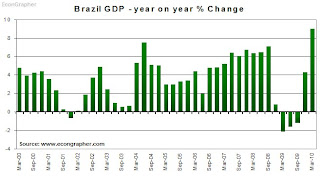Brazil’s economic is the largest among all South American and also is the world's eighth largest in nominal GDP and ninth largest in purchasing power parity. Brazil has moderately free markets and inward-oriented economy. Besides that, Brazil is one of the fastest-growing major economies in the world with an average annual GDP growth rate of 5%. Brazil's economy grew at its fastest rate in at least 14 years in the first three months of 2010. Its GDP surged by 9% compared with the same period a year earlier.
Brazil is characterized by large and well-developed agricultural, mining, manufacturing, and service sectors, Brazil's economy outweighs that of all other South American countries and Brazil is expanding its presence in world markets. Since 2003, Brazil has steadily improved macroeconomic stability, building up foreign reserves, reducing its debt profile by shifting its debt burden toward real denominated and domestically held instruments, adhering to an inflation target, and committing to fiscal responsibility. In 2008, Brazil became a net external creditor, Brazil's external debt totaled less than its foreign reserve holdings, and two ratings agencies awarded investment grade status to its debt. After record growth in 2007 and 2008, the onset of the global financial crisis hit Brazil in September 2008. The Brazil was the 10 biggest purchasing parity countries in the world with $2.013 trillion in US dollar in 2009. Brazil’s inflation rate was 4.2% in 2009.
Brazil's currency and its stock market (Bovespa) saw large swings as foreign investors pulled resources out of Brazil. Brazil experienced two quarters of recession, as global demand for Brazil's commodity-based exports dwindled and external credit dried up. However, Brazil was one of the first emerging markets to begin a recovery. Consumer and investor confidence revived and GDP growth returned to positive in the second quarter, 2009. The Central Bank expects growth of 5% for 2010. The Brazil economy has been predicted to become one of the five largest economies in the world.
So we can see Brazil’s economic was growth very fast. But the Much of Brazil's economy is driven by domestic consumer demand rather than exports; it means the Brazil domestic demand was better than Brazil exports. The Brazil’s distribution family income was 56.7. It means Brazilian is affordable to buy baby milk powder; the price of baby milk powder won’t bring a big problem to Brazilian.
Brazil’s freedom to start, operate, and close a business is limited by Brazil’s regulatory environment. Starting a business takes more than three times the world average of 35 days, and obtaining a business license takes much longer than the global average of 218 days. So it will quite hard to export baby milk powder to Brazil.
In 2008, Brazil’s weighted average tariff rate was 7.9 percent. Import bans and restrictions, market access barriers in services, high tariffs, border taxes and fees, restrictive regulatory and licensing rules, subsidies, complex customs procedures, and problematic protection of intellectual property rights add to the cost of trade.

No comments:
Post a Comment